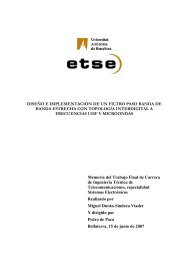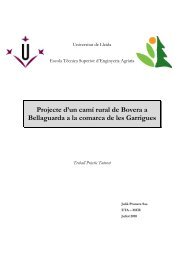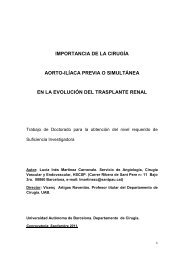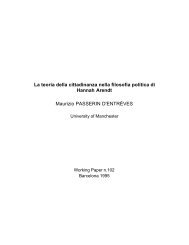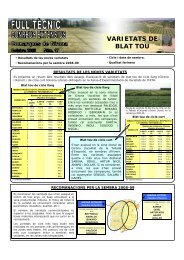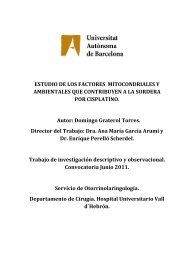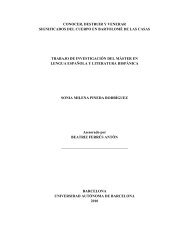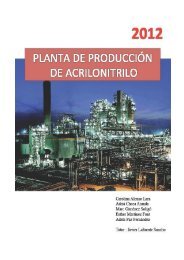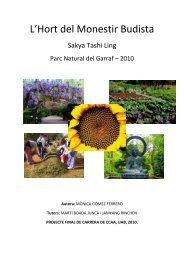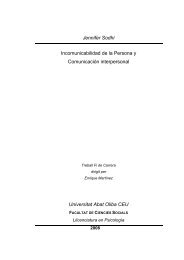la evolucion de la teoria de los efectos de los medios de ... - Recercat
la evolucion de la teoria de los efectos de los medios de ... - Recercat
la evolucion de la teoria de los efectos de los medios de ... - Recercat
You also want an ePaper? Increase the reach of your titles
YUMPU automatically turns print PDFs into web optimized ePapers that Google loves.
disonancia cognitiva, y veamos <strong>los</strong> aspectos específicos <strong>de</strong> <strong>la</strong> percepción <strong>de</strong>l clima <strong>de</strong><br />
opinión en <strong>la</strong> teoría <strong>de</strong> <strong>la</strong> espiral <strong>de</strong>l silencio.<br />
A <strong>la</strong> hora <strong>de</strong> investigar empíricamente cómo perciben <strong>los</strong> individuos el clima <strong>de</strong><br />
opinión, Noelle-Neumann, siguiendo <strong>la</strong> metodología <strong>de</strong> <strong>la</strong>s encuestas <strong>de</strong>moscópicas,<br />
intenta encontrar herramientas que directamente arrojen datos sobre el clima <strong>de</strong> opinión.<br />
La principal herramienta consta <strong>de</strong> dos preguntas: primero preguntar al<br />
entrevistado su propia opinión al respecto <strong>de</strong> un tema, y luego preguntarle acerca <strong>de</strong><br />
cuál cree que es <strong>la</strong> opinión <strong>de</strong> <strong>la</strong> mayoría respecto a ese mismo tema. Otra <strong>de</strong> <strong>la</strong>s<br />
herramientas más útiles es <strong>la</strong> <strong>de</strong> preguntar acerca <strong>de</strong>l futuro, como por ejemplo “tal y<br />
cómo están <strong>la</strong>s cosas, ¿qué piensa usted, cómo serán <strong>la</strong>s opiniones <strong>de</strong>ntro <strong>de</strong> un año?”, o<br />
“habrá más o menos gente que hoy a favor <strong>de</strong>…?” (NOELLE-NEUMANN, 1995, 31).<br />
En este tipo <strong>de</strong> preguntas, <strong>la</strong>s respuestas indican cómo percibe <strong>la</strong> gente el clima <strong>de</strong><br />
opinión respecto a un tema en concreto y esas predicciones indican el grado <strong>de</strong> potencia<br />
o <strong>de</strong>bilidad <strong>de</strong> una opinión. Sin embargo, tal y como advierte <strong>la</strong> misma Noelle-<br />
Neumann, es <strong>de</strong> esperar un fenómeno l<strong>la</strong>mado looking-g<strong>la</strong>ss perception, “an<br />
overestimate of one`s own opinion when assesing ‘how most people think’”<br />
(HAMMELINK & LINNÉ, 1994, 109). Entre mayor sea <strong>la</strong> correspon<strong>de</strong>ncia entre <strong>la</strong><br />
propia opinión y <strong>la</strong> opinión atribuida a <strong>la</strong> mayoría, con mayor seguridad se trata <strong>de</strong> un<br />
clima <strong>de</strong> opinión transmitido por <strong>los</strong> <strong>medios</strong> <strong>de</strong> comunicación (HAMMELINK &<br />
LINNÉ, 1994, 109).<br />
De todos modos, para comprobar el po<strong>de</strong>r que tienen <strong>los</strong> <strong>medios</strong> <strong>de</strong><br />
comunicación en <strong>la</strong> formación <strong>de</strong> <strong>la</strong> opinión pública transmitiendo ciertos climas <strong>de</strong><br />
opinión, <strong>la</strong> metodología a<strong>de</strong>cuada en este caso es el sistema <strong>de</strong> panel, en el que diversos<br />
sujetos son entrevistados varias veces en un <strong>de</strong>terminado <strong>la</strong>pso <strong>de</strong> tiempo. Así,<br />
“if the same persons are interviewed repeteadly, and changes in attitu<strong>de</strong> only<br />
appear for certain media users groups, the panel <strong>de</strong>sign serves to keep most of the<br />
characteristics on which spurious corre<strong>la</strong>tions could be based constant, and the probability<br />
that changes should be interpreted as the effect of the media thus increases”<br />
(HAMMELINK & LINNÉ, 1994, 110).<br />
En este tipo <strong>de</strong> investigaciones se recogen <strong>la</strong>s i<strong>de</strong>as principales <strong>de</strong> <strong>la</strong> teoría <strong>de</strong>l<br />
knowledge gap don<strong>de</strong> <strong>los</strong> individuos más expuestos a <strong>los</strong> <strong>medios</strong> comunicación se harán<br />
eco en mayor grado <strong>de</strong> <strong>los</strong> climas <strong>de</strong> opinión promovidos por <strong>los</strong> <strong>medios</strong> <strong>de</strong><br />
50



